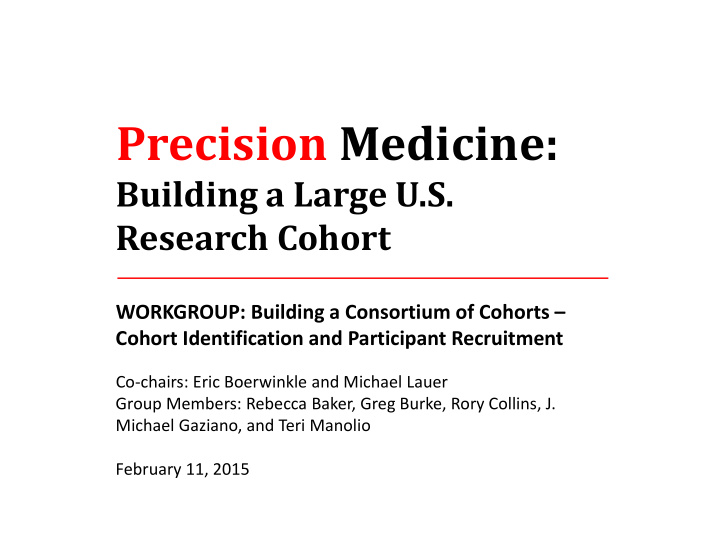



Precision Medicine: Building a Large U.S. Research Cohort WORKGROUP: Building a Consortium of Cohorts – Cohort Identification and Participant Recruitment Co ‐ chairs: Eric Boerwinkle and Michael Lauer Group Members: Rebecca Baker, Greg Burke, Rory Collins, J. Michael Gaziano, and Teri Manolio February 11, 2015
Current Landscape: Resources Numerous cohorts already exist and are: • Richly phenotyped and ethnically diverse • Enriched with valuable longitudinal data • Invested in materials, including DNA samples • Supported by enthusiastic researchers and informed consenting participants • But … are not harmonized (data, rules)
Construction of a National Cohort Cohort C Cohort A Cohort B Pool and Harmonize Research Now Enhanced Cohort 1 New Data Sources Follow Up New Sequence Data Enhanced Cohort 2 Research Later New Participants Enable short ‐ term and long ‐ term research studies
Challenges • Feasibility and $ • Technologies • Fragmentation – coordination – data platforms – delivery systems • Incentives http://s3.amazonaws.com/media.wbur.org/wordpress/11/files/2013/09/0911 ‐ heart ‐ study ‐ e1378918245880.jpg http://files.itproportal.com/wp ‐ content/uploads/photos/iphone5_vs_galaxy_s3_600_original.jpg
Expense, time, and feasibility: Concern: Costly, lengthy, and logistically challenging . Proposed Solution: Leverage existing resources – Extensive genomic/ ‐ omic data – Recruitment complete or ongoing – Electronic data, digital communities – Enable new participants and methods
Technology: Concern: Rapidly evolving technologies Proposed Solution: Leverage and grow with – Bidirectional internet and cloud ‐ based services – Mobile devices (smartphones, sensors) – Home monitoring devices, web ‐ based portals – Electronic health records and digitized registries
Coordination, transparent governance: Concern: A common infrastructure is lacking . Proposed Solution: Coordinating center to – Harmonize existing data – Facilitate testing of new data collection methods Proposed Solution: Steering committee to advise on – Policy, management, and scientific direction – Approaches to reduce marginal cost of new studies
Incentives: Concern: What is the new value (vs threat)? Proposed Solution: Offer new value – Whole genome sequencing – Digital patient ‐ reported outcomes – Data derived from novel devices and apps – Larger harmonized samples for analyses – Analyze findings within broader contexts
Opportunities & Big, Audacious Ideas A Large US Research Cohort could make possible • An enormous, versatile “scientific commons” • Dialogues of researchers and participants • Studies of health and well ‐ being • Platforms for rapid, efficient randomized trials • Evidence ‐ based precision medicine as reality
Recommend
More recommend